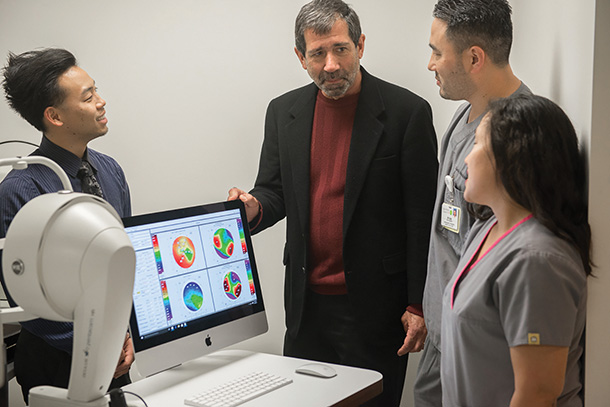The USC Gayle and Edward Roski Eye Institute has established the Ophthalmic Technician Education Program (OTEP) to prepare highly skilled allied health care professionals to serve the eye care needs of individuals of all ages. The 21-month program, one of only 14 programs nationally, is the only one in California that prepares individuals to become Certified Ophthalmic Technicians (COT).
OTEP is a non-degree, certificate education/training program that integrates core academic knowledge with clinical and occupational skill mastery. Course content ranges from the basics of history taking, medical ethics, eye and visual system anatomy, physiology, and pathology and patient relations to specialty areas including lensometry, refractometry, optical coherence tomography, ophthalmic imaging and surgical assisting.
OTEP students practice professional and technical skills through weekly clinical rotations at the USC Roski Eye Institute, LAC+USC Medical Center and Children’s Hospital Los Angeles. This supervised real-world experience prepares graduates to assist ophthalmologists in the prevention, detection, and treatment of vision impairments in a variety of settings including private practice offices, hospitals and community based clinics.
A career as an ophthalmic technician offers the opportunity for professional advancement. Ophthalmic technicians may seek additional certification in subspecialty areas including Ophthalmic Surgical Assisting Certification (OSA), Ophthalmic Scribe Certification (OSC), Registered Ophthalmic Ultrasound Biometrist (ROUB), Certified Diagnostic Ophthalmic Sonographer (CDOS) and Corporate Certified Ophthalmic Assistant (CCOA).
Classes for OTEP begin Jan. 9, 2017, and applications to the program are accepted on a rolling basis. Potential candidates for the program range from recent high school graduates to veterans interested in an allied health career. Financial aid through federal and private institutions is available to qualified students. More information about OTEP, including application materials, can be found at http://eye.keckmedicine.org/otep/. Interested individuals also may email questions to reiotep@usceye.org.
— L. Alexis Young


